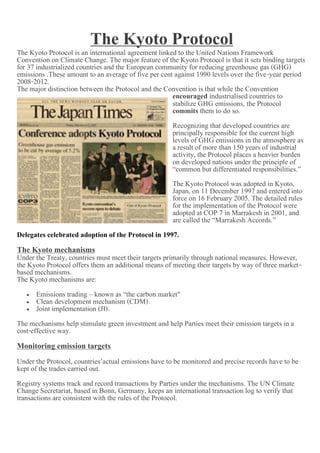
Glowbal worming
- 1. The Kyoto Protocol Framework The Kyoto Protocol is an international agreement linked to the United Nations Convention on Climate Change. The major feature of the Kyoto Protocol is that it sets binding targets for 37 industrialized countries and the European community for reducing greenhouse gas (GHG) emissions .These amount to an average of five per cent against 1990 levels over the five-year period 2008-2012. The major distinction between the Protocol and the Convention is that while the Convention encouraged industrialised countries to stabilize GHG emissions, the Protocol commits them to do so. Recognizing that developed countries are principally responsible for the current high levels of GHG emissions in the atmosphere as a result of more than 150 years of industrial activity, the Protocol places a heavier burden on developed nations under the principle of “common but differentiated responsibilities.” The Kyoto Protocol was adopted in Kyoto, Japan, on 11 December 1997 and entered into force on 16 February 2005. The detailed rules for the implementation of the Protocol were adopted at COP 7 in Marrakesh in 2001, and are called the “Marrakesh Accords.” Delegates celebrated adoption of the Protocol in 1997. The Kyoto mechanisms Under the Treaty, countries must meet their targets primarily through national measures. However, the Kyoto Protocol offers them an additional means of meeting their targets by way of three market- based mechanisms. The Kyoto mechanisms are: Emissions trading ‟ known as “the carbon market" Clean development mechanism (CDM) Joint implementation (JI). The mechanisms help stimulate green investment and help Parties meet their emission targets in a cost-effective way. Monitoring emission targets Under the Protocol, countries’actual emissions have to be monitored and precise records have to be kept of the trades carried out. Registry systems track and record transactions by Parties under the mechanisms. The UN Climate Change Secretariat, based in Bonn, Germany, keeps an international transaction log to verify that transactions are consistent with the rules of the Protocol.
- 2. Reporting is done by Parties by way of submitting annual emission inventories and national reports under the Protocol at regular intervals. A compliance system ensures that Parties are meeting their commitments and helps them to meet their commitments if they have problems doing so. Adaptation The Kyoto Protocol, like the Convention, is also designed to assist countries in adapting to the adverse effects of climate change. It facilitates the development and deployment of techniques that can help increase resilience to the impacts of climate change. The Adaptation Fund was established to finance adaptation projects and programmes in developing countries that are Parties to the Kyoto Protocol. The Fund is financed mainly with a share of proceeds from CDM project activities. The road ahead The Kyoto Protocol is generally seen as an important first step towards a truly global emission reduction regime that will stabilize GHG emissions, and provides the essential architecture for any future international agreement on climate change. By the end of the first commitment period of the Kyoto Protocol in 2012, a new international framework needs to have been negotiated and ratified that can deliver the stringent emission reductions the Intergovernmental Panel on Climate Change (IPCC) has clearly indicated are needed. argets The targets cover emissions of the six main greenhouse gases, namely: „ Carbon dioxide (CO2); „ Methane (CH4); „ Nitrous oxide (N2O); „ Hydrofluorocarbons (HFCs); „ Perfluorocarbons (PFCs); and „ Sulphur hexafluoride (SF6) The maximum amount of emissions (measured as the equivalent in carbon dioxide) that a Party may emit over the commitment period in order to comply with its emissions target is known as a Party’s assigned amount. The individual targets for Annex I Parties are listed in the Kyoto Protocol's Annex B. Though most of the world ratified the Kyoto Protocol, the United States did not. As for its success so far, to mangle a quote of Mark Twain's, the news of Kyoto's failure is premature. (See also: http://bit.ly/xQkML )
- 3. Countries included in Annex B to the Kyoto Protocol and their emissions targets Country Target (1990** - 2008/2012) EU-15*, Bulgaria, Czech Republic, Estonia, Latvia, Liechtenstein, -8% Lithuania, Monaco, Romania,Slovakia,Slovenia, Switzerland US*** -7% Canada, Hungary, Japan, Poland -6% Croatia -5% New Zealand, Russian Federation, Ukraine 0 Norway +1% Australia +8% Iceland +10% * The 15 States who were EU members in 1997 when the Kyoto Protocol was adopted, took on that 8% target that will be redistributed among themselves, taking advantage of a scheme under the Protocol known as a “bubble”, whereby countries have different individual targets, but which combined make an overall target for that group of countries. The EU has already reached agreement on how its targets will be redistributed. ** Some EITs have a baseline other than 1990. *** The US has indicated its intention not to ratify the Kyoto Protocol. Note: Although they are listed in the Convention’s Annex I, Belarus and Turkey are not included in the Protocol’s Annex B as they were not Parties to the Convention when the Protocol was adopted. Upon entry into force, Kazakhstan, which has declared that it wishes to be bound by the commitments of Annex I Parties under the Convention, will become an Annex I Party under the Protocol. As it had not made this declaration when the Protocol was adopted, Kazakhstan does not have an emissions target listed for it in Annex B. Amendment to Annex B of the Kyoto Protocol The Protocol mirrors the Convention in recognizing the specific needs and concerns of developing countries, especially the most vulnerable among them. Annex I Parties must thus provide information on how they are striving to meet their emissions targets while minimizing adverse impacts on developing countries. An Adaptation Fund was established to finance concrete adaptation projects and programmes in developing countries that are Parties to the Kyoto Protocol. The Fund is to be financed with a share of proceeds from clean development mechanism (CDM) project activities and receive funds from other sources. more source: http://unfccc.int/kyoto_protocol/items/2830.php